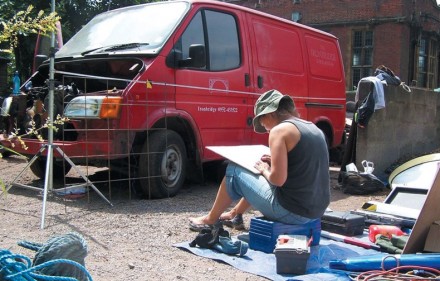Lista archport
Mensagem

[Archport] Remains of the day
|
In New Statesman,
19-2-2009 http://www.newstatesman.com/society/2009/02/garden-remains-excavation Remains of the day Published 19 February 2009 Observations on
excavation
A Bristol University archaeologist at work
on the 1991 Ford Transit van Three years ago, archaeologists at Bristol University
embarked on a unique research project: the excavation of a 1991 Ford Transit
van. After some background research, they carefully collected up all the dog
hairs and sweet wrappers before stripping back the layers of carpet, plywood
lining, metal and rust. Some of their discoveries were fairly trivial, such as
the revelation that the van's roof was badly dented after serving as an
impromptu diving board at a riotous Christmas party. But there were also
intriguing insights into social history. After fingerprint dusting on the
bodywork drew a blank, they learned that the van was one of the first vehicles
in the country to be built entirely by robots, which coincided with a wave of
redundancies at Ford's Southampton plant. Now the dismantled van has become the
flagship project for a booming scholarly area, the archaeology of the
"contemporary past". This is not as great a departure as you might think. The
popular image of archaeology may be about romantic quests to uncover lost
civilisations, but deep excavation is only one part of a field that begins with
the mundane reading of documents, geophysical surveys and surface
investigations. There is no reason why any of this needs to be limited to the
ancient or exotic. Even Channel 4's Time Team, who generally get excited about
Roman bathhouses and Saxon burial grounds, have run programmes about the D-Day
landings and warplane crash sites. Contemporary archaeology is a response to the problem of
preserving and recording our disposable, rapidly changing culture. The
structures of the postwar era - 1960s tower blocks, mobile-phone masts,
distribution warehouses, retail parks - are fairly temporary and likely to
disappear quickly. That is why Change and Creation, an archaeological project
on the late 20th-century landscape run by English Heritage, is focusing on
transient sites such as the code-breaking huts at Bletchley Park or the
Greenham Common peace camp. The latter is now slowly turning from airbase
concrete to its original grassy state, but is offering up piecemeal evidence of
its former life in the form of moss-covered children's toys and anti-American
graffiti. All historians, and not merely archaeologists, are
likely to encounter difficulties researching our own era because so much of the
material will be ephemeral or intangible. The historian Niall
Ferguson recently said that he did not envy future members of his profession,
because of the "disappearing decision trail" in the contemporary
period. The archival record of the present day is likely to be both too scarce
and too abundant. Email databases may not survive, or they will be so full that
no scholar will know where to start, or they will be unreadable because of
changes to hardware or software. So perhaps we will have to rely on the
archaeologists, whose whole training teaches them to make wider deductions from
fragmentary material remains - the smudge of black on pottery providing proof
of a hearth, for example. Just imagine how much an archaeologist could unearth about
our lives from excavating a typical suburban garden. All the changing fashions
of the Ground Force era, from water features to decking, would show how that
little plot of land became a hive of DIY creativity and social expectation. Timber
remains would reveal that, across the country over the past half-century, back
garden fences doubled in height from three to six feet. The dendrochronologists
would discover that the neat shrubs and conifers at the garden's borders
satisfied a similar need for privacy. A quick dig in the front garden would lay
bare a lawn replaced with block paving for a car - the simplest and easiest way
to increase the price of a house, with the unintended side effect of making the
whole area more prone to flooding. Just like archaeologists at ancient sites,
the garden excavators could use the scrappiest evidence to extrapolate a wealth
of social detail about our privatised, mobile, weekend-oriented lives. Contemporary archaeology is an egalitarian endeavour.
Anyone can excavate the half-buried evidence of the recent past. I have
just been for a walk along my street, combing the pavement for archaeological
remains. I discovered several dozen red rubber bands discarded by careless
postmen; a fragment of burst balloon, almost certainly a survival from a front
door decorated for someone's birthday; and a recession-era flyer for an
electrician ("Your local bright spark!!"), saying "No job too
small" and "Call anytime!!!". It looks as if this street will
offer rich pickings for an intrepid Time Team of the not-too-distant future. |
| Mensagem anterior por data: Re: [Archport] Canal Arqueohoje no Youtube | Próxima mensagem por data: [Archport] Lei da Rolha |
| Mensagem anterior por assunto: [Archport] Relic reveals Noah's ark was circular | Próxima mensagem por assunto: [Archport] Rememorar Conimbriga |
